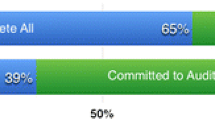Abstract
Massive Online Open Courses (MOOCs) can create large scale communities of learners who collaborate, interact and discuss learning materials and activities. MOOCs are often delivered multiple times with similar content to different cohorts of learners. However, research into the differences of learner communication, behavior and expectation between multiple presentations is scarce. This is of importance to MOOC developers, academics and moderators, as an understanding of these differences could have an impact on content provision, community moderation, course delivery, learner interactions, and completion rates. This case study of two presentations of a Futurelearn History MOOC examined learner activity data, and pre and post course learner survey results (n = 10,449). Differences in learner survival rates, behavior, expectation, recruitment, experience of online learning, demographic makeup, reasons for non-completion, and comment activity were identified. These results form a preliminary exploration of learner community differences between multiple MOOC presentations that guide future analyses by identifying areas of comparative interest and importance.



Similar content being viewed by others
References
Breslow, L. B., Pritchard, D. E., DeBoer, J., Stump, G. S., Ho, A. D., & Seaton, D. T. (2013). Studying learning in the worldwide classroom: Research into edX’s first MOOC. Research and Practice in Assessment, 8, 13–25.
Brinton, C., Chiang, M., Jain, S., Lam, H., Liu, Z., & Wong, F. (2013). Learning about social learning in MOOCs: From statistical analysis to generative model. IEEE Transactions on Learning Technologies, 7(4), 346–359.
Clarà, M., & Barberà, E. (2013). Learning online: Massive open online courses (MOOCs), connectivism, and cultural psychology. Distance Education, 34(1), 129–136.
Class Central (2016). By the numbers: MOOCs In 2015. Retrieved from https://www.class-central.com/report/moocs-2015-stats/.
Clow, D. (2013). MOOCs and the funnel of participation. Proceedings of the Third International Conference on Learning Analytics and Knowledge. ACM.
DeSilets, L. D. (2013). No longer a passing fad. Journal of Continuing Education in Nursing, 44(4), 149–150.
Eisenhardt, K. M. (1989). Building theories from case study research. The Academy of Management Review, 14(4), 532–550.
Fleckhammer, L., & Wise, L. (2011). The role of tutors in facilitating online student engagement. In Paper presented at the Ascilite Hobart. Australia.
Fournier, H., Kop, R., & Sitlia, H. (2011). The value of learning analytics to networked learning on a personal learning environment. In Paper presented at the proceedings of the 1st international conference on learning analytics and knowledge. Banff, Alberta, Canada.
Glance, D. G., Forsey, M., & Riley, M. (2013). The pedagogical foundations of massive open online courses. First Monday, 18(5). http://128.248.156.56/ojs/index.php/fm/article/view/4350.
Gomm, R., Hammersley, M., & Foster, P. (2000). Case study method: Key issues, key texts. Thousand Oaks, California: Sage Publications.
Guàrdia, L., Maina, M., & Sangrà, A. (2013). MOOC design principles. A pedagogical approach from the learner’s perspective. eLearning Papers 33. http://r-libre.teluq.ca/596/1/In-depth_33_4.pdf.
Hew, K. F. (2015). Promoting engagement in online courses: What strategies can we learn from three highly rated MOOCS. British Journal of Educational Technology,. doi:10.1111/bjet.12235.
Ho, A., Reich, J., Nesterko, S., Seaton, D., Mullaney, T., & Waldo, J., et al. (2014). HarvardX and MITx: The first year of open online courses, fall 2012-summer 2013. Retrieved from http://harvardx.harvard.edu/multiple-course-report.
Kop, R., Fournier, H., & Mak, J. S. F. (2011). A pedagogy of abundance or a pedagogy to support human beings? Participant support on massive open online courses. International Review of Research in Open and Distance Learning, 12(7), 74–93.
Liyanagunawardena, T. R., Adams, A. A., & Williams, S. A. (2013). MOOCs: A systematic study of the published literature 2008–2012. The International Review of Research in Open and Distance Learning, 14(3), 202–227.
Machun, P. A., Trau, C., Zaid, N., Wang, M., & Ng, J. (2012). MOOCs: Is there an app for that? Expanding mobilegogy through an analysis of MOOCs and iTunes University. In Web Intelligence and Intelligent Agent Technology (WI-IAT), 2012 IEEE/WIC/ACM International Conferences (Vol. 3, pp. 321–325). Chicago: IEEE.
Milligan, C. (2012). Change 11 SRL-MOOC study: initial findings. Retrieved from http://worklearn.wordpress.com/2012/12/19/change-11-srl-mooc-study-initial-findings/.
Moore, J. L., Dickson-Deane, C., & Galyen, K. (2011). e-Learning, online learning, and distance learning environments: Are they the same? The Internet and Higher Education, 14(2), 129–135. doi:10.1016/j.iheduc.2010.10.001.
Morris, N., Swinnerton, B., & Hotchkiss, S. (2015). Can demographic information predict MOOC learner outcomes? In Paper presented at the eMOOCs Conference, Mons, Belgium. http://www.emoocs2015.eu/sites/default/files/Papers.pdf.
Rodriguez, O. (2012). MOOCs and the AI-Stanford like courses: Two successful and distinct course formats for massive open online courses. European Journal of Open, Distance and E-Learning 15(2).
Swanson, G. E. (1971). Social change. Foresman: Scott.
Toven-Lindsey, B., Rhoads, R. A., & Lozano, J. B. (2015). Virtually unlimited classrooms: Pedagogical practices in massive open online courses. The Internet and Higher Education, 24, 1–12. doi:10.1016/j.iheduc.2014.07.001.
Tschofen, C., & Mackness, J. (2012). Connectivism and dimensions of individual experience. International Review of Research in Open and Distance Learning, 13(1), 124–143.
Veletsianos, G., & Shepherdson, P. (2016). A systematic analysis and synthesis of the empirical MOOC literature published in 2013–2015. The International Review of Research in Open and Distributed Learning. doi:10.19173/irrodl.v17i2.2448.
Wright, F. (2013). What do librarians need to know about moocs? D-Lib Magazine, 19(3–4), 6.
Yin, R. K. (2009). Case study research: design and methods. Thousand Oaks, California: Sage Publications.
Zhang, K., & Toker, S. (2011). Stimulating critical thinking in a virtual learning community with instructor moderations and peer reviews. Knowledge Management and E-Learning, 3(4), 534–547.
Acknowledgments
The researchers would like to acknowledge the provision of activity data and the administration of the pre and post surveys by Futurelearn in both presentations of the MOOC.
Author information
Authors and Affiliations
Corresponding author
Ethics declarations
Conflict of interest
The authors declare that they have no conflict of interest.
Rights and permissions
About this article
Cite this article
Gallagher, S.E., Savage, T. Comparing learner community behavior in multiple presentations of a Massive Open Online Course. J Comput High Educ 28, 358–369 (2016). https://doi.org/10.1007/s12528-016-9124-y
Published:
Issue Date:
DOI: https://doi.org/10.1007/s12528-016-9124-y




